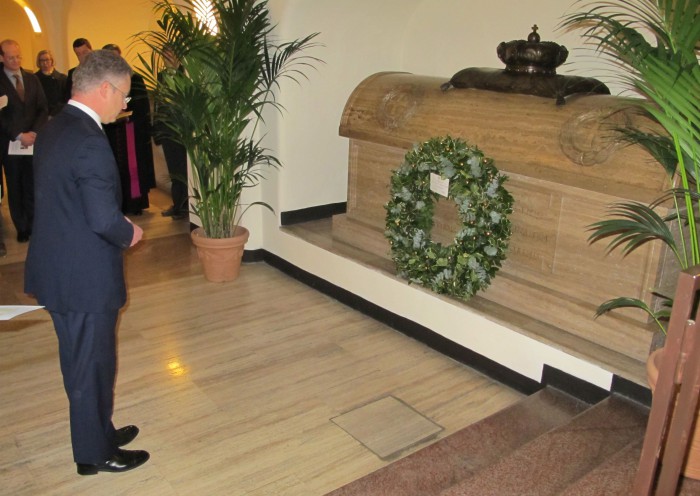
On 8 January, with the gracious permission of Her Majesty The Queen, I laid a wreath at the tomb in the crypt of St Peter’s Basilica of James Francis Edward Stuart, 250 years after his burial there. The message on the wreath was very simple: “In memoriam – James Francis Edward Stuart – ‘The Chevalier’ – 1688-1766”.
Why, you may ask? What has that to do with the British Embassy to the Holy See?
James Francis Edward Stuart had other names. ‘The Chevalier’ to his friends and admirers, he was “The Old Pretender” to his enemies (to distinguish him from his eldest son, ‘Bonnie’ Prince Charlie, ‘The Young Pretender’), and to his supporters – and, when it suited him, King Louis XIV of France – King James III of England and Ireland, VIII of Scotland. He was the son of James II, deposed in the ‘Glorious Revolution’ of 1688 after a crisis precipitated by his son’s birth, and lived and died in exile. After his death in Rome on New Year’s Day 1766, Pope Clement XIII accorded him the honour of a magnificent State Funeral the following 8 January. In his lifetime, successive Popes always recognised him as King. However, significantly, Clement XIII did not extend that recognition to his sons, in tacit and later explicit recognition of the Hanoverian succession.
So our simple wreath-laying ceremony was, in a way, one of historical reconciliation. The Chevalier always considered himself a patriot, and his court in exile welcomed Britons of all political and religious stripes. His younger son, Henry Benedict, Cardinal York, received a pension from the British Crown after his lands had been seized by Napoleon, and the Prince Regent offered to contribute to the magnificent Stuart monument by Canova that can still be seen in St Peter’s. The tomb in the crypt where I laid the wreath was restored by Queen Elizabeth the Queen Mother, through the good offices of my predecessor, Sir D’Arcy Osborne, in the early 1940’s. And in 2012 HRH The Duke of Gloucester unveiled a restored Coat of Arms of Cardinal York in the Pontifical Scots College, where the original Stuart gravestones had been transferred.
Memory runs deep in Rome. Cardinal Comastri, Archpriest of St Peter’s Basilica (and, as such, a successor of Cardinal York) participated in the wreath-laying ceremony. The Holy See Secretary for Relations with States, Archbishop Gallagher, also attended alongside a number of other senior Holy See officials. The Rectors of the Irish, Scots and Venerable English Colleges – whose predecessors were fired by Clement XIII in 1766 for their untimely enthusiasm for the Stuart cause – attended alongside the Rector of the Pontifical Beda College, representing the British and Irish seminaries in Rome. As did Anglican, Methodist and Church of Scotland guests.
The Chevalier was known for his deep faith, but I hope would have been pleased to have seen participants across the ecumenical divide at this occasion. The presence of the Irish ambassador to the Holy See also reminded us of the importance of commemorating together, rather than remembering apart. The past leaves many wounds. But do not underestimate the healing power of history and remembrance, done well.
